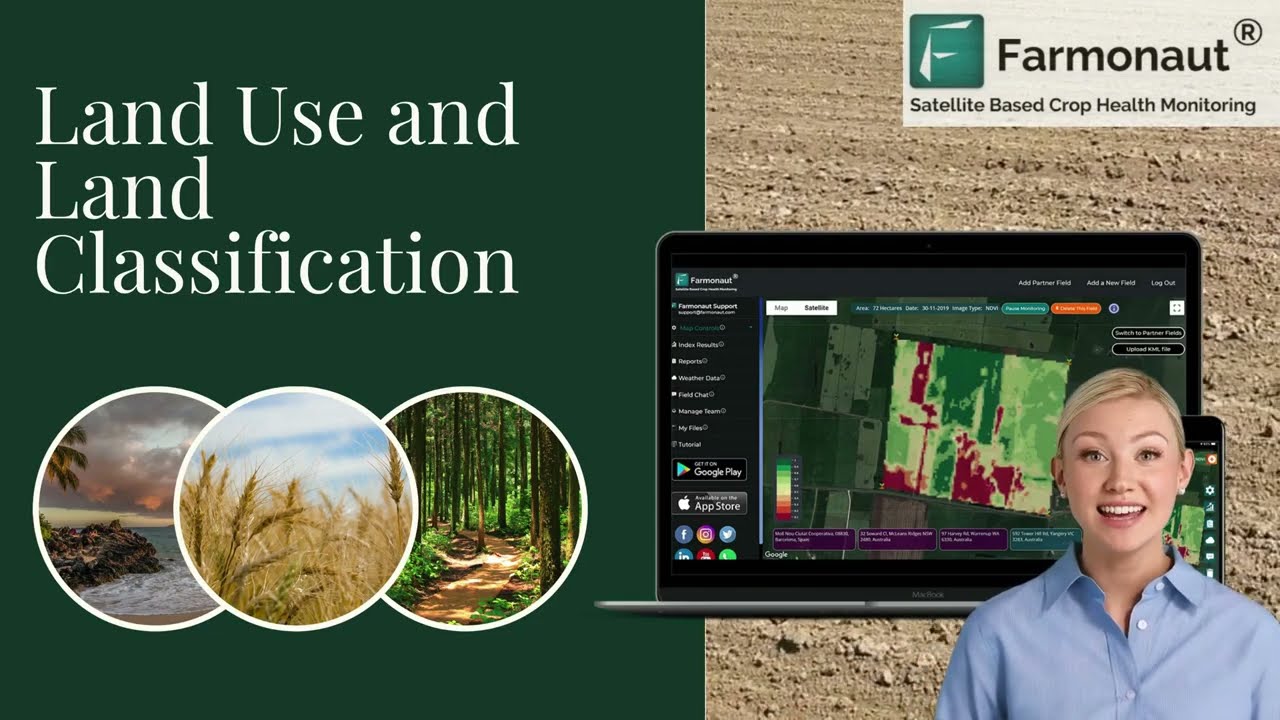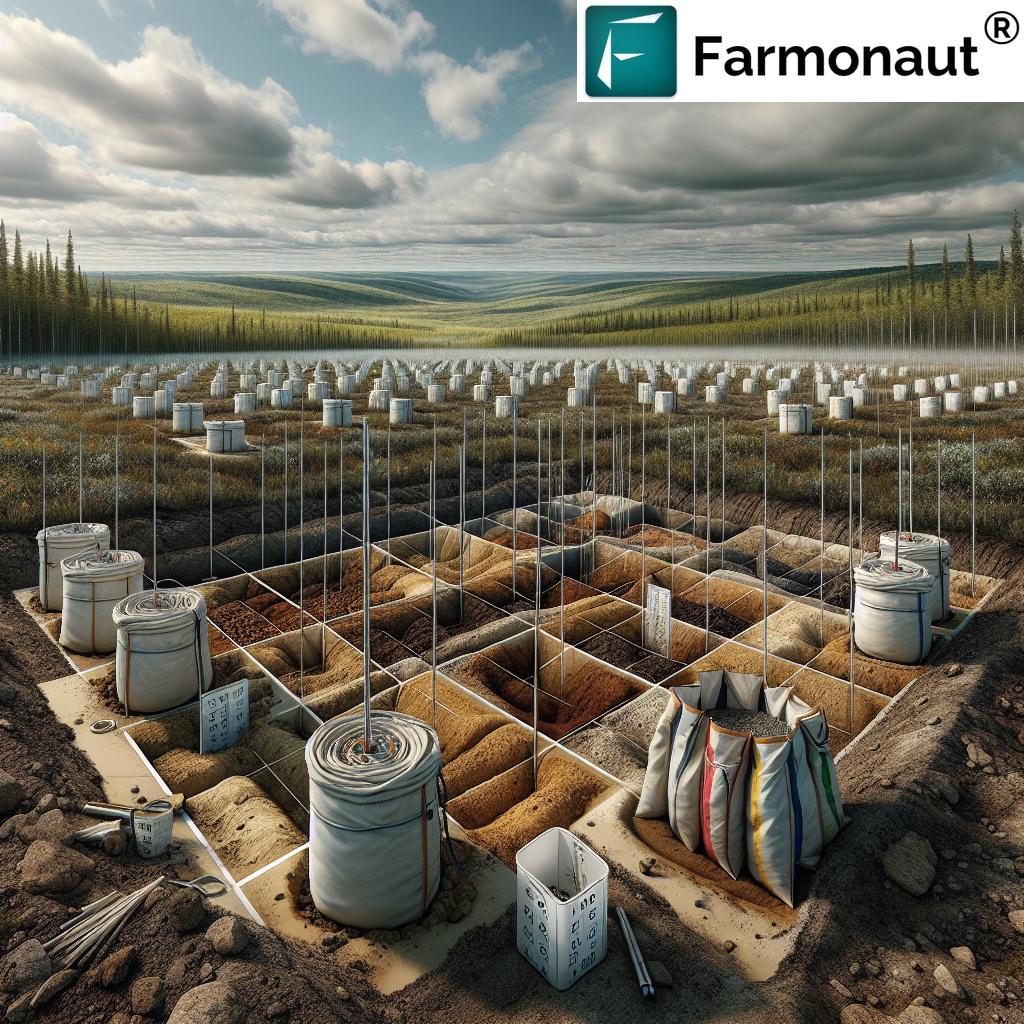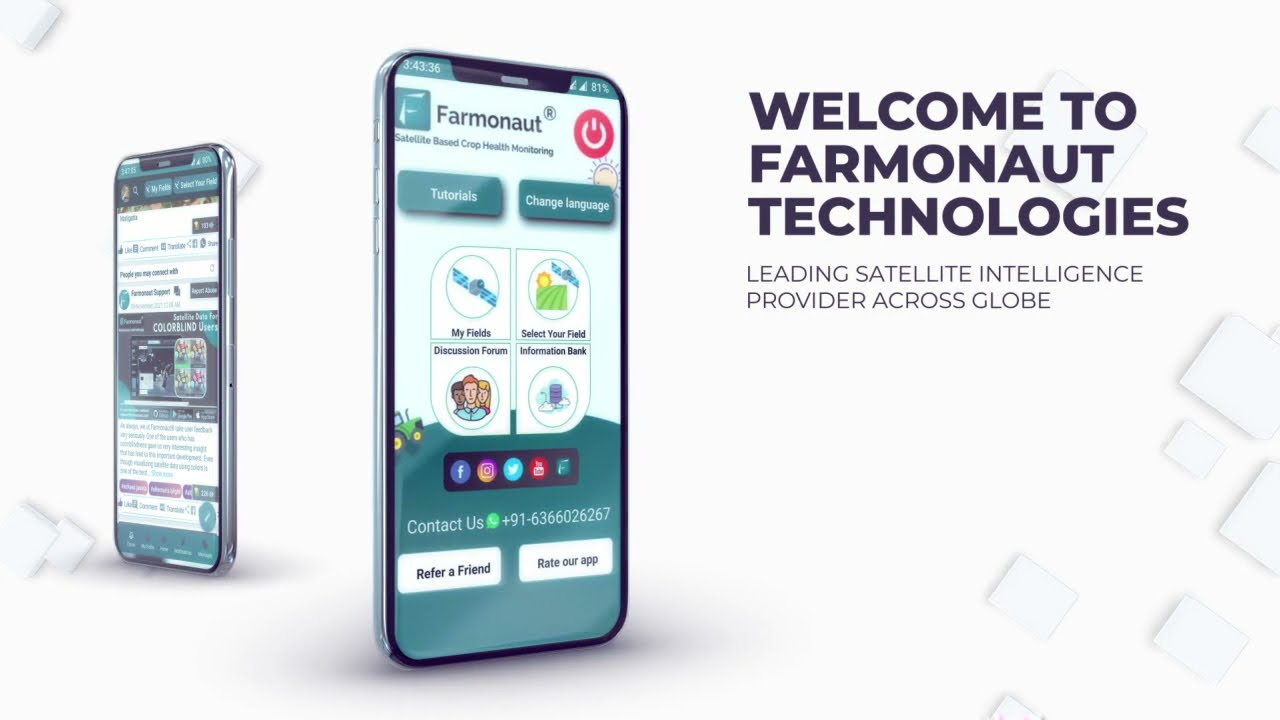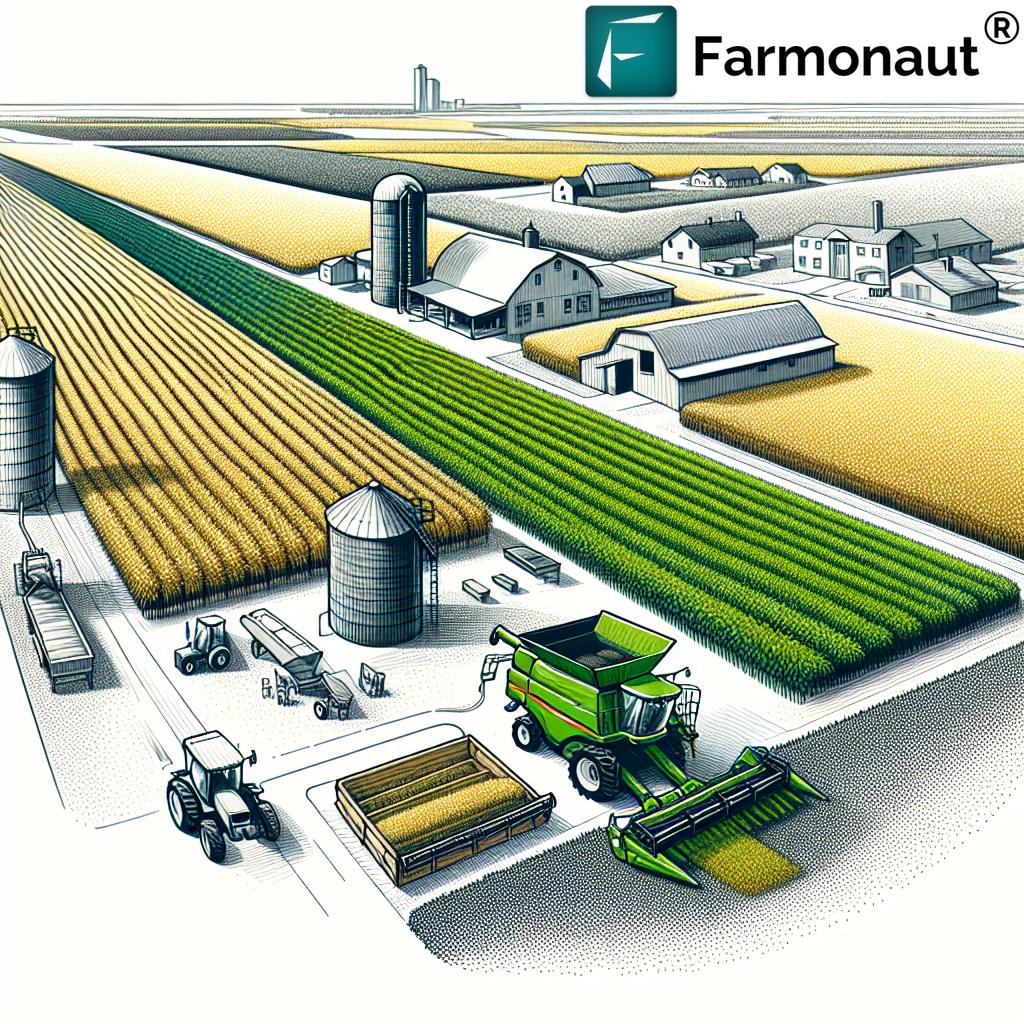5 Key Soil Survey Insights for Rare Earth Exploration in Manitoba
Table of Contents
- Introduction: The Evolution of Rare Earth Exploration in Canada
- A New Era in Soil Survey Techniques & Trends
- Comparative Methodologies Table: Soil Sampling, Geochemical Analysis, & Metagenomic Sequencing
- Insight 1: Systematic Soil Sampling Strategies in Manitoba
- Insight 2: Advanced Geochemical Analysis in Alberta & Manitoba
- Insight 3: Exploring Metagenomic Sequencing as a Soil Survey Trend
- Insight 4: Defining Intrusive System Patterns and Carbonatite Zones
- Insight 5: Integrating Environmental and Mineralization Data for Resource Development
- Farmonaut’s Role: Precision Agriculture & Environmental Monitoring
- Farmonaut Subscription Plans
- FAQ: Soil Surveys & Rare Earth Mineral Exploration
- Summary & Conclusion
Introduction: The Evolution of Rare Earth Exploration in Canada
Rare earth element (REE) exploration is transforming the natural resources landscape, especially in mineral-rich regions such as Manitoba and Alberta, Canada. As global demand for critical minerals spikes—driven by technological, clean energy, and defense sectors—so too does the urgency in developing efficient, low-impact, and high-yield extraction strategies.
Our focus is on how soil survey innovations, notably advanced soil sampling, geochemical analysis, and metagenomic sequencing, are addressing industry needs for precision, environmental sustainability, and resource optimization in rare earth exploration in Canada. Integral Metals Corp.’s 2024 geomicrobial survey at the Burntwood Project in northern Manitoba offers a window into modern best practices—combining the search for mineralization with leading-edge science.
Through the lens of the Burntwood Syenite-Carbonatite Complex—a regional intrusive system renowned for its prospective REE deposits—we’ll present five critical soil survey insights that underlie current and future development efforts.
We also spotlight the role of actionable, technology-driven tools like the Farmonaut Carbon Footprinting solution—enabling responsible, data-driven decisions across mineral and agriculture sectors.
A New Era in Soil Survey Techniques & Trends
The journey from soil sampling in the field to pinpointing rare earth mineralization zones reflects innovation on multiple fronts:
- Traditional methods: Grid-based collection, laboratory analysis, often limited by labor intensity, spatial coverage, and resolution.
- Modern geochemical analysis: Elemental profiling, pathfinder geochemistry, AI-driven anomaly detection, and integration of large datasets.
- Metagenomic sequencing: Using microbial biosignatures as indirect indicators of subsurface geology and REE presence—ushering in new frontiers of exploration.
This convergence is transforming mineralization survey Canada and environmental survey mineral development. Manitoba’s focus on 16S rRNA and full metagenomic sequencing soil profiling, as seen in the Burntwood Project, demonstrates growing adoption and results-driven deployment.
Comparative Methodologies Table: Soil Sampling, Geochemical Analysis, & Metagenomic Sequencing
To understand the technological progression in rare earth exploration in Canada, compare effectiveness, adoption, and insights of the most significant soil survey methods in use across Manitoba and Alberta:
| Method | Estimated Effectiveness for Rare Earth Discovery | Industry Adoption Rate (2024, %) | Estimated Cost Efficiency | Typical Insights Yielded |
|---|---|---|---|---|
| Traditional Soil Sampling | Moderate | 95% | High | Baseline geochemical data, simple anomaly detection, broad spatial coverage |
| Geochemical Analysis | High | 72% | Medium | Multi-element profiles, identification of pathfinder elements, refined targeting |
| Metagenomic Sequencing | Very High (emerging) | 38% | Medium-Low | Microbial community patterns, indirect mineralization signals, depth of ecosystem-gas interaction analysis |
Key takeaway: While traditional soil sampling in Manitoba provides a foundation, geochemical analysis in Alberta and Manitoba brings scalable precision, and metagenomic sequencing delivers game-changing detail for unexplored or complex mineralization. Cost trends and adoption rates echo a shift towards higher data-density, multi-class datasets in rare earth element exploration Canada.
Insight 1: Systematic Soil Sampling Strategies in Manitoba
Our first key insight centers on how modern soil sampling in Manitoba leverages systematic, grid-based methods to ensure robust and unbiased coverage of prospective REE zones. The Burntwood Project exemplifies this approach with over 800 unique soil samples collected from:
- Confirmed carbonatite intrusion zones
- Background areas (for baseline comparison)
- A systematic geochemical sampling grid covering the broader project area
The adoption of dense, reproducible sampling grids:
- Enables fine spatial resolution in anomaly detection
- Facilitates rapid comparison between intrusive system zones and background soils
- Supports statistical validation of microbial and chemical shifts linked to mineralization
With these established methodologies, exploration teams in Canada can focus efforts on high-prospectivity targets—helping reduce drilling risk and optimize resource allocation across large development areas.
Resource Tip: Efficient grid sampling not only enriches mineral exploration but can also be applied to Farmonaut’s Fleet Management solutions—optimizing logistics for sample collection and environmental monitoring.
Insight 2: Advanced Geochemical Analysis in Alberta & Manitoba
Second, we observe geochemical analysis propelling rare earth discovery by merging high-throughput laboratory assays with in-field portable XRF and multispectral sensors. Key practices in geochemical analysis Alberta and Manitoba include:
- Comprehensive multi-element profiling for REE and pathfinder elements (e.g., Nb, Ta, Zr, Th, U)
- Correlation of elemental enrichment/depletion with underlying geological structures
- Application of AI/machine learning to rapidly interpret complex geochemical datasets
Example: At Burntwood, both soil and plant geochemical samples undergo analysis at Saskatchewan Research Council (SRC), integrating data to enhance exploration targeting.
This level of geochemical rigor:
- Supports the definition of “fingerprint” elemental signatures around carbonatite intrusion zones
- Allows for cross-validation with microbial and mineralogical observations
- Drives down false positives, focusing field campaigns on genuinely prospective areas
Industry Relevance: Geochemical analysis now underpins a new wave of environmental survey mineral development—balancing exploration effectiveness with stewardship of natural systems.
See also: Explore Farmonaut’s Carbon Footprinting capability for real-time tracking of emissions and support for sustainable resource development across mineral and agriculture projects.
Insight 3: Exploring Metagenomic Sequencing as a Soil Survey Trend
Groundbreaking for mineralization survey Canada, metagenomic sequencing soil introduces a new data dimension—microbial “pathfinders” for subsurface REE mineralization. In the 2024 Burntwood survey, scientists analyzed all 808 soil samples using both 16S rRNA and whole-metagenome sequencing.
Key findings:
- Statistically significant depletion of Burkholderiales and enrichment of Rhizobiales in samples overlying confirmed carbonatite systems
- LEfSe (Linear Discriminant Analysis Effect Size) detects microbial shifts linked to REE mineral presence and underlying geology
- Microbial community patterns offer a “biological fingerprint” for indirect mineralization targeting—especially useful in covered or difficult terrain
The integration of biogeochemistry with traditional geochemical methods is revolutionizing rare earth exploration in Canada, especially as sequencing adoption grows:
- Enables discovery in blind or deep cover zones
- Reduces environmental disturbance compared to heavy drilling
- Promotes data-driven precision for future mineral resource development
Commercial Note: Farmonaut’s Satellite Data API and API Developer Docs offer scalable integration of geospatial and environmental data—powerful for research teams, agribusinesses, and technical service providers in the mining sector.
Insight 4: Defining Intrusive System Patterns and Carbonatite Zones
Mineralization controls in rare earth exploration in Canada are often associated with regional intrusive systems—such as the Burntwood Syenite-Carbonatite Complex in Manitoba. Our fourth insight examines how integrating geological, geochemical, and microbial datasets:
- Distinguishes intrusive system extents and defines the geometry of carbonatite intrusion zones
- Maps subtle soil and microbial patterns indicative of REE-bearing structures—outpacing traditional mapping in speed and resolution
- Clarifies the links between environmental changes and REE mineralization, supporting regulatory and reporting requirements for critical mineral resources Manitoba
Cutting-edge statistical models (e.g., LEfSe) and AI-driven geospatial analytics offer not just a digital “map” but a living, multidimensional view of how mineralization affects both soil chemistry and resident biosystems.
Environmental Impact: Responsibly distinguishing mineralized from background areas protects untouched land and streamlines environmental surveys during project development and permitting phases.
See how geospatial precision and environmental management can further benefit broad land management with Farmonaut’s Large Scale Farm Management solutions.
Insight 5: Integrating Environmental and Mineralization Data for Resource Development
The fifth and final insight is the integrated use of geomicrobial, geochemical, geological, and environmental data. This new paradigm shifts rare earth exploration from isolated workflows to a holistic, data-rich process encompassing sampling, analysis, and environmental stewardship.
At Burntwood and similar projects, integration includes:
- Comprehensive analysis of rock, soil, and plant geochemistry to confirm and refine anomalies
- Continuous overlay of microbial community data to track subtle environmental gradients associated with mineralization zones
- Cross-platform digital management—enabling secure data sharing, regulatory compliance, and transparent reporting rooted in real-time evidence
Benefits include:
- Precision target identification and drilling prioritization, minimizing environmental footprint and accelerating discovery
- Proactive adaptation to regulatory and social license requirements, positioning Manitoba and Alberta as leaders in responsible mineral resource development
- Cost reductions and enhanced ESG (Environmental, Social, Governance) performance
Technological Synergy: This level of integration aligns with Farmonaut’s Crop Loan & Insurance Verification solutions, leveraging satellite-based data collection and blockchain for compliance, transparency, and risk minimization across sectors.
Farmonaut’s Role: Precision Agriculture & Environmental Monitoring
While our main focus is on rare earth mineral exploration, technology transfer from advanced tech platforms like Farmonaut empowers the full spectrum of resource development:
-
Satellite-Based Crop and Soil Monitoring: Multispectral, high-frequency imagery to detect crop stress, soil moisture—and environmental changes linked to land use or mineral exploration.
This capability underpins compliance with evolving regulations in Canada and supports sustainability standards for both farmers and mining operators. - AI-Driven Advisory Systems: Real-time insights to optimize resource allocation, reduce losses, and support farm and exploration productivity.
- Blockchain-Based Traceability: Verifiable supply chain audit trails vital for trust, financing, and consumer confidence, especially in critical minerals and agriculture. Explore Farmonaut’s Product Traceability solution for full supply chain transparency.
- Fleet and Resource Management: Simultaneous tracking of vehicles, logistics, and machinery, driving efficiency and reducing environmental impact for exploration and production alike.
- Environmental Impact Assessment: Fast, scalable carbon footprint tracking for critical mineral resources Manitoba and sustainable reporting.
For advanced agro-advisory on crops, plantation planning, and forestry management compatible with both farm and exploration needs, try our Farmonaut Agro Advisory tools.
Platform Accessibility: Farmonaut’s ecosystem is available as an Android & iOS app, web platform, and API for broad adoption—unlocking advanced analytics for every stakeholder in the resource value chain.
Farmonaut Subscription Plans
Explore flexible, scalable subscription plans designed for everyone from single-farm users to large agribusinesses and research organizations:
Start today: Access our full platform to experience earth observation insights, precision management, and sustainable reporting.
FAQ: Soil Surveys & Rare Earth Mineral Exploration
What are rare earth elements and why are they critical?
Rare earth elements (REEs) are a group of 17 metallic elements essential in modern technologies such as electronics, renewable energy, defense, and advanced manufacturing. Their unique magnetic, catalytic, and luminescent properties make them crucial for strategic industries and the energy transition.
How does soil sampling contribute to rare earth exploration in Canada?
Systematic soil sampling enables the mapping of elemental concentrations and the detection of pathfinder signals that indicate the possible presence of REE mineralization. In regions like Manitoba, this forms the foundation for grid-based exploration and guides efficient drill targeting.
What makes geochemical analysis impactful in Alberta and Manitoba?
Geochemical analysis in Alberta and Manitoba increases exploration accuracy by identifying target zones with specific elemental patterns linked to REE-bearing minerals and carbonatite intrusions. The integration of AI, portable sensors, and multi-element assays elevates data resolution and reduces false leads.
Why is metagenomic sequencing considered a breakthrough in mineral surveys?
Metagenomic sequencing detects shifts in soil microbial communities caused by geochemical changes associated with hidden mineralization. It introduces a biological layer of indirect mineral detection, especially beneficial in heavily covered or unexposed terrain in Canada.
How does Farmonaut support resource development and environmental monitoring?
Farmonaut offers advanced, satellite-driven monitoring of crop health, soil conditions, weather, and carbon footprint. Its API and advisory tools provide actionable insights for responsible resource management—from precision agriculture to environmental stewardship in mining regions.
Can Farmonaut’s solutions aid exploration projects outside agriculture?
Yes, Farmonaut’s geospatial, traceability, and resource management solutions are designed for broad application—including mineral exploration, land reclamation, environmental monitoring, supply chain authentication, and project ESG reporting.
Summary & Conclusion
The future of rare earth exploration in Canada—particularly in Manitoba and Alberta—rests on data-driven, environmentally conscious, and high-resolution soil survey strategies. Our exploration of five key insights underscores a shift toward integration and innovation:
- Systematic, grid-based soil sampling in Manitoba ensures full spatial coverage and unbiased anomaly detection.
- Advanced geochemical analysis elevates accuracy and depth for resource targeting in both Alberta and Manitoba.
- Metagenomic sequencing soil uncovers unique microbial signatures, pioneering indirect mineralization pathfinding.
- Holistic mapping of intrusive system analysis and carbonatite intrusion zones reveals detailed, actionable patterns for future development.
- Integrated, multidimensional analysis enhances environmental survey mineral development, regulatory compliance, and sustainable resource utilization.
Innovation in soil survey methodologies—mirrored by technologies like those offered by Farmonaut—herald a new era of precision and environmental responsibility in resource exploration. By leveraging satellite data, advanced analytics, and seamless integration across digital platforms, we can support the balanced development of critical mineral resources in Manitoba, empowering not just the mining sector but agricultural, environmental, and governmental stakeholders across Canada.
For real-time solutions in environmental and resource monitoring, access our full suite of tools on the Farmonaut Web and Mobile App today.
Explore. Analyze. Develop—sustainably. The future of Canadian resources starts beneath your feet.






















